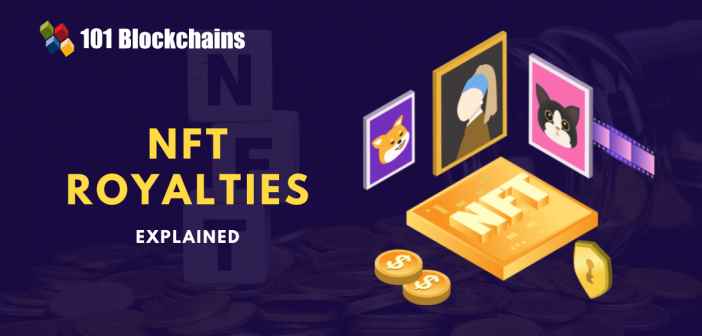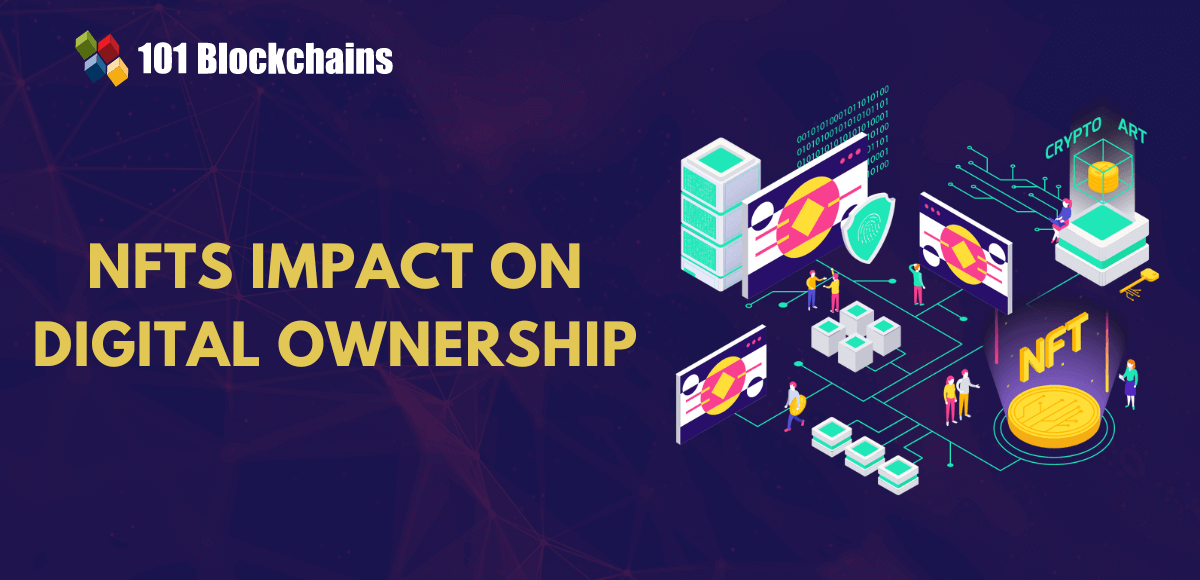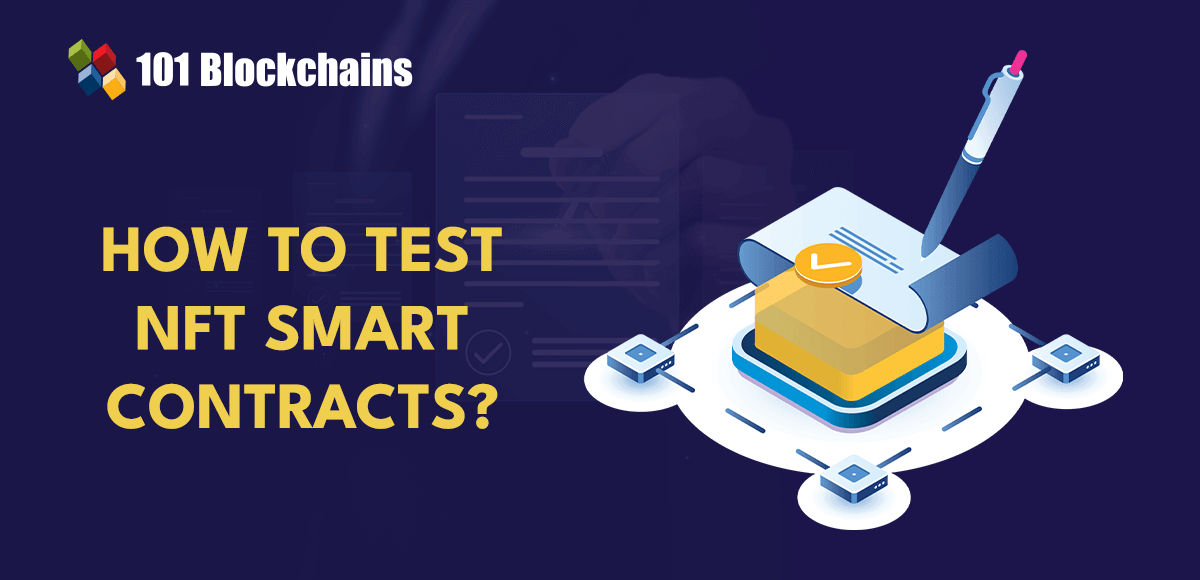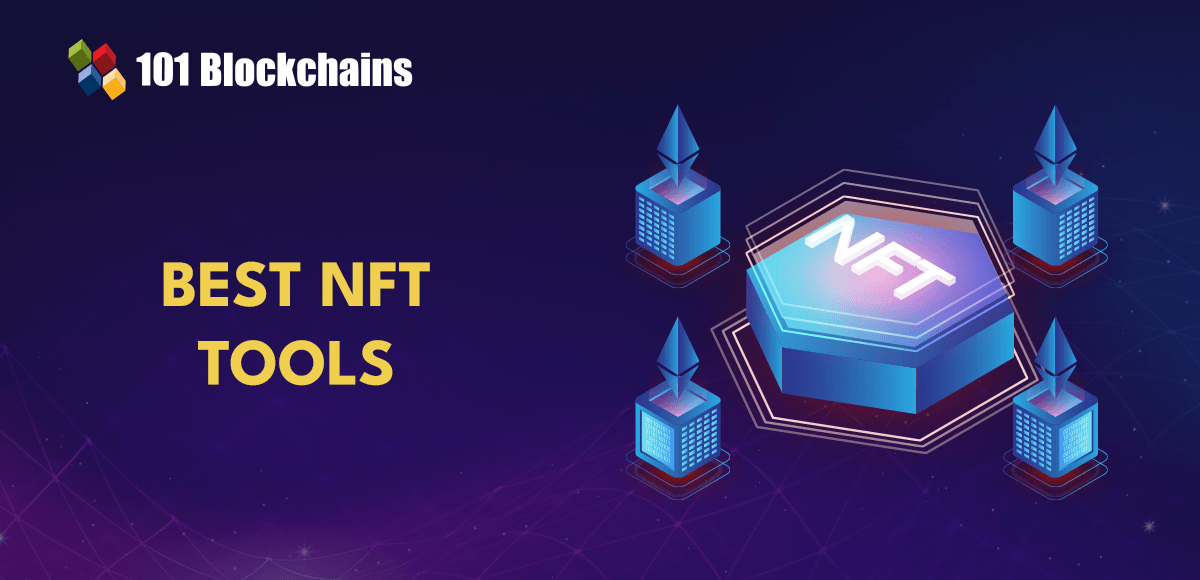Learn how blockchain truly works, master key definitions, and uncover what makes smart contracts so "smart." Dive into the fundamentals, gain valuable insights, and start your blockchain journey today!

- NFT
James Howell
- on January 02, 2023
What are NFT Royalties and how does it Work?
Royalty payments, commonly referred to as royalties, have been one of the significant instruments in the broader financial landscape. Royalties are the payments by one party to another for using the latter’s assets. For example, music artists allow online streaming services, other musicians, or radio stations to play their records in exchange for a certain amount of fees. How will a description of NFT royalties explained for beginners help in such cases?
Interestingly, non-fungible tokens have introduced significant advantages for resolving the setbacks associated with conventional royalty payment systems. What is the impact of NFTs on royalties and the underlying mechanisms? The following discussion attempts to offer an answer with an introduction to NFT royalties and their work. In addition, learners can also identify their advantages alongside the economics driving NFT royalties.
Definition of NFT Royalties
Before you look for any NFT royalties example, you must focus on the definition of NFT royalties. What are NFT royalties, and are they any different from conventional royalty payments? NFT royalties are payments to the original creator for every secondary sale of digital assets created by them.
The rules for royalty payments with an NFT are coded on smart contracts available in blockchain networks. Creators could set the percentage of the royalty payment in the minting stages. When a secondary sale of the NFT is completed, the smart contract will allocate the specified percentage from the sale as a royalty payment to the creator.
One of the most popular examples of passive earnings based on NFT royalties percentage would refer to the “Crossroads” NFT by Beeple. The resale of the NFT on the secondary market fetched around $6.6 million, and the creator received 10% of the transaction as a royalty payment. Therefore, you can notice how NFT royalties offer a powerful instrument for the monetization of different works of art.
Build your identity as a certified blockchain expert with 101 Blockchains’ Blockchain Certifications designed to provide enhanced career prospects.
What Is the Need for NFT Royalties?
Every new technological innovation draws attention to the reason behind introducing it. Who needs NFT royalties and why? Artists may have found a newer and larger audience for their work with social media and online exposure. However, it is important to understand how artists and content creators have to work continuously on producing work to sustain their lives.
NFT royalties arrived as the solution for such issues of artists seeking sustainable business models for their future. The answers to ‘how to do NFT royalties work’ should always be preceded with an explanation for their existence in the first place. Which problems are responsible for the newfound attention on NFT royalties?
Artists in almost every sector, including composers, songwriters, novelists, producers, and almost any individual associated with creative processes, have to struggle to obtain fair compensation. For example, many artists have to allow streaming services to use their work in return for a trivial royalty fee. Once an artist sells off their creation, they do not have any control over the secondary sales or royalties.
The discussion on NFT royalties explained for beginners would emphasize how they bring back power to the hands of artists. Harvey Ball, the famous creator of the yellow smiley face, sold his work for only $45 in 1963. Almost 40 years later, in 2000, the t-shirt company which used the yellow smiley face sold the iconic piece for around $500,000,000.
Another example of an artist’s work being undervalued would refer to Robert Rauschenberg. Robert had sold one of his paintings at $900 in 1958, which was sold for $85,000 only a few years later. As you can notice, resale royalty rights could have helped Harvey and Robert gain a piece from the secondary sales. Therefore, NFT royalties can offer a flexible avenue for artists to collect resale payments.
Want to get an in-depth understanding of non-fungible tokens (NFTs)? Enroll now in the NFT Fundamentals Course
Working of NFT Royalties
The need for music NFT royalties and royalty payments for other artists clearly establish the significance of NFT royalty payments. According to the definition, NFT royalties work by smart contracts, which define the share of royalty payments from secondary sales. The smart contract ensures the automation of royalty payments as it enforces the rules defined for every secondary sale of an NFT.
Smart contracts verify the secondary sale, reserve a percentage of the sale as royalty payment and deliver it to the creator. In addition, you don’t have any intermediaries managing the process of non-fungible token royalty payments. On top of it, secondary sellers or buyers could not interfere in the royalty payment process.
Most important of all, you must remember that royalties are not applicable to all NFTs. The answers to ‘How to do NFT royalties work’ would emphasize the necessity of incorporating the terms for royalties in the NFT smart contracts. You can have the benefits of royalties on secondary NFT sales only if you have specified the terms clearly on smart contracts. Non-fungible token royalty payments are applicable for digital content, in-game items and collectibles, physical gaming accessories, and other assets.
The proposition of royalties with non-fungible tokens is a crucial highlight for many content creators and artists. However, the most dominant aspect in the operations of NFT royalties points to the marketplaces, which can facilitate varying royalty systems. For example, new marketplaces such as Bluebox feature distinctly innovative approaches for enabling better benefits for content creators.
Excited to develop an in-depth understanding of solidity’s best practices and the tools needed for developing and testing an NFT marketplace, Enroll now in the NFT Development Course
How Does the Royalty Percentage Work?
The basic impression of how NFT royalties work reflects only how you can expect them to behave. However, it is also important to know how to check NFT royalties to make the most of their benefits. The good news for you is that all the royalties can be tracked on-chain. On the other hand, it still does not offer an accurate impression of how you could access NFT royalties.
The easiest way to dive into the technicalities of how NFT royalties work would refer to the royalty percentage. NFT creators could determine the percentage of royalty on secondary sales, and the NFTs would help them earn the desired royalty on all future sales of the non-fungible token. How do you identify the way royalty percentages work in practice?
As of now, it is important to note that all NFT marketplaces don’t offer the option of including royalties. However, you can find popular marketplaces such as Rarible joining in the trend by allowing creators to incorporate royalties in their work during the minting process. Assume that an NFT creator has developed an NFT on Rarible.
Now, a follower of the artist purchases the NFT artwork for 10 ETH, thereby implying that the creator made 10 ETH for their work. At the same time, the creator has also included an NFT royalties percentage of 10% for secondary sales of the NFT. What would happen when the buyer decides to auction the NFT artwork at a higher price?
Let us imagine that the buyer hosted an auction for the NFT artwork and fetched 300ETH in a secondary sale. The smart contract in the NFT would be triggered upon a secondary sale, and it would reserve 10% of the sale, i.e., 30ETH for the original creator. Similarly, the new buyer might want to sell off the NFT art piece at a higher price. At the end of it all, the original creator would receive royalties for every subsequent sale of their work.
Want to learn about the Ethereum Technology? Enroll now in Ethereum Technology Course.
Are NFT Royalties Reliable?
The outline of the NFT royalties example shows how digital artists and content creators could leverage royalties to earn true value for their work. At the same time, you might have doubts regarding the credibility of NFT royalties. For starters, it is important to keep in mind that NFT royalties are not subject to any legal jurisdiction.
On the other hand, you must also note that NFT royalty systems are based on blockchain technology. Blockchain offers an immutable and transparent decentralized ledger for the documentation of all NFT transactions. First of all, blockchain helps safeguard the authenticity and integrity of NFTs. Subsequently, the smart contracts serve as automated protocols that work on enforcing the conditions outlined for royalties on the concerned NFT.
The most striking aspect in the outline of ‘how do NFT royalties work’ would refer to the removal of intermediaries. As a result, artists could find desired relief from corruption and other pressing concerns in conventional royalty payments. Blockchain and smart contracts can work in unison to ensure the proper identification of the author. In addition, the automated payment to the original creator upon completion of the transaction also removes the concerns of fraud.
Start learning Non-Fungible Token with World’s first NFT Skill Path with quality resources tailored by industry experts Now!
Is it Possible to Transfer Royalties?
The rise of multiple NFT marketplaces with the advantages of interoperability has offered a formidable boost to the NFT economy. However, it has also created questions about the possibilities of transferring NFT royalties between different marketplaces. Learners must notice that the royalty policies do not transfer automatically with the transfer of non-fungible tokens between marketplaces.
In addition, the discrepancies in the NFT royalties percentage policy on different marketplaces can be confusing. For example, the OpenSea marketplace supports royalties for collections only rather than individual pieces. Therefore, an NFT listed on OpenSea after being sold on Rarible would not entitle the creator to any royalties. On top of it, OpenSea allows a maximum royalty limit of up to 10% rather than the 50% permitted on Rarible.
What is the Significance of Optional Royalties?
The effectiveness of NFT royalties has already been brought under the radar before their mainstream recognition. Do you have doubts about how to check NFT royalties through on-chain mechanisms? Interestingly, some of the emerging marketplaces have been shifting away from the NFT royalty system. Examples of marketplaces opting for NFT royalty systems include Magic Eden, X2Y2, and LooksRare.
Therefore, the optional royalty system is an exclusive solution that helps NFT buyers uphold the royalty policy of artists for secondary purchases. Why do you need optional royalties on NFT sales? Royalty policies for non-fungible tokens are scripted on immutable smart contracts. However, the Ethereum blockchain could not enforce specific stipulations regarding token transfers. The marketplace decided how they want to enforce the NFT smart contracts in the traditional royalty system.
In the case of optional royalties, buyers would have the option of implementing the smart contract for royalty payments. Optional royalties are unique NFT royalties examples, where the payment of royalty depends on the buyer. Seems like a disadvantage for the creators, isn’t it? Some platforms, such as LooksRare, have decided to share around 25% of their protocol fees with creators to alleviate the effects of optional royalties.
Some of the artists have started blacklisting the NFT marketplaces, which evade royalties. For example, popular NFT artist, Tyler Hobbs, included the X2Y2 marketplace in the blacklist for his QQL collection. On the other hand, NFT marketplaces could still come up with new ways to support optional royalties. The NFT ecosystem, ImmutableX, has been working on developing a community-managed blacklist and whitelist to ensure broader enforcement of royalties.
Are NFT Royalties Really Effective?
The concept of NFT royalties explained the easiest solution for problems in conventional royalty systems. However, it is also important to identify how NFT royalties serve benefits for the target audience, i.e., artists and content creators. In the early stages of the NFT revolution, various projects and artists could obtain million in royalties from secondary sales. On the other hand, the secondary market is not the same anymore as bearish market conditions prevail. At the same time, many platforms are joining the trend of excluding royalties, thereby leading to a decline in revenue.
Many NFT projects have been shut down due to the existing conditions for the secondary NFT market. On the other hand, some projects, such as DeGods, have completely removed the option of royalties. In such cases, the effectiveness of NFT royalties would depend considerably on the scale of the project.
For example, large projects with external revenue sources could afford royalty payments. In the case of individual artists, the royalty revenue can outweigh the earnings from the original mint. Irrespective of the challenges in enforcing NFT royalties, they are quite effective for artists. It is also important to note how optional royalties could prompt radical growth in total trading volume while the royalty fees dropped to almost zero.
Learn the concept, elements, future and use cases of NFTs from the E-book: Non Fungible Tokens (NFTS) – A Definitive Guide
Is It Reasonable to Remove NFT Royalties?
The scope for optional royalties presents a formidable challenge to music NFT royalties and other NFT royalty systems. However, it is difficult to deny the reasons why marketplaces should exclude NFT royalties. Traders seeking better profit margins on secondary sales of NFTs are more likely to welcome the concept of removing royalties.
At the same time, it is also important to notice the economics underlying such decisions and their potential impact. Removing NFT royalties would most likely encourage a race to the bottom of the NFT market. Therefore, the network effects of a platform’s decision to include optional royalties could spread across interoperable NFT ecosystems.
One of the examples of platforms switching to optional royalties would be Magic Eden, which supports Solana as well as Ethereum-powered NFTs. The marketplace could offer incentives to NFT marketplaces based on both blockchain networks. On the other side, the trend of excluding royalties has not affected the NFT ecosystems on blockchains like Cardano.
Interestingly, the NFT trading volume on Cardano exceeds way beyond that of Solana. Many experts have pointed out that the demand for royalties has spurred the growth of Cardano NFT volume. Evidently, an artist-friendly environment played a vital role in bringing in many new artists and NFT projects to the Cardano NFT ecosystem.
Get familiar with the terms related to non-fungible token with Non-Fungible Token Flashcards
Benefits of NFT Royalties
The doubts regarding ‘how to check NFT royalties’ and optional royalty benefits can create confusion regarding the value of NFT royalties. Therefore, beginners need a clear impression of how NFT royalties are beneficial for the emerging class of unique assets. One of the primary advantages of earning royalties on NFTs points to the facility of passive income. NFT creators could receive a sustainable source of passive income from royalties on their work.
As a result, NFT artists could gradually improve their earnings from passive income with every passing year. Another significant reason for focusing on NFT royalties points to the broad range of benefits of NFT holders. Royalties also serve as an indication of how the work of a particular artist gains value as time passes. Therefore, the royalty payments to creators could also strengthen the reputation of an NFT artist in the market.
Want to know about the key processes of NFTs? Check the presentation Now on How NFT Works
Bottom Line
The introductory guide to NFT royalties explained the concept of incorporating royalties into smart contracts. Creators can specify the royalty payments they want on subsequent secondary sales of the NFT artwork or asset. The royalty percentage and NFT marketplace are critical pointers in the working of non-fungible token royalties. Royalties offer an exclusive opportunity for content creators and artists to maximize their earning potential.
At the same time, royalty payments are also an indicator of the value of an artist’s work. The examples of music NFT royalties also suggest the possibility of applying royalties on different types of NFTs. However, certain setbacks with NFT royalty systems have prompted the introduction of concepts such as optional royalty. Learn more about NFTs and become a certified NFT professional for leveraging royalty payments on your own NFT collection now.
*Disclaimer: The article should not be taken as, and is not intended to provide any investment advice. Claims made in this article do not constitute investment advice and should not be taken as such. 101 Blockchains shall not be responsible for any loss sustained by any person who relies on this article. Do your own research!






